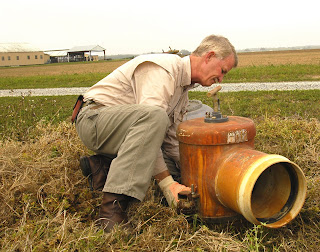
APRIL 9
It’s been a long time since we’ve seen sleet in South Louisiana. But who would have expected frozen precipitation in April? But that’s exactly what happened April 7. Fortunately, the temperatures didn’t get low enough to result in frost.
As expected after passage of a strong cold front, the south wind that came by April 13 was intense. Larry White, manager of the seed program at the LSU AgCenter Rice Research Station, said the cold and wind combined had a definite impact on the young rice plants.
Here’s a rice plant from the field being monitored in this blog.
Dr. Johnny Saichuk, LSU AgCenter rice specialist, said young rice plants can be protected from a frost or freeze with an insulating layer of water.
Saichuk additionally shared his thoughts on the impacts of the cold in his weekly field notes:
Will the yellowed plants affect the harvest with lower yields? “That’s a long time from now,” Larry White said.
He said the DD50 computer program for projecting a rice crop’s timetable indicates that this field should be harvested by July 23, about a week sooner than most harvests at the station. But the earlier planting moved the harvest back.
 The Rice Station recorded 1.9 inches of rain in the past 24 hours, and more is expected today. The picture above was taken Wednesday afternoon between storms. More rain is predicted for today. Rice farmers who haven't flooded their fields yet, the rain will save on the costs of pumping, but for farmers whose fields were flooded, the rain is of little consequence.
The Rice Station recorded 1.9 inches of rain in the past 24 hours, and more is expected today. The picture above was taken Wednesday afternoon between storms. More rain is predicted for today. Rice farmers who haven't flooded their fields yet, the rain will save on the costs of pumping, but for farmers whose fields were flooded, the rain is of little consequence.
























